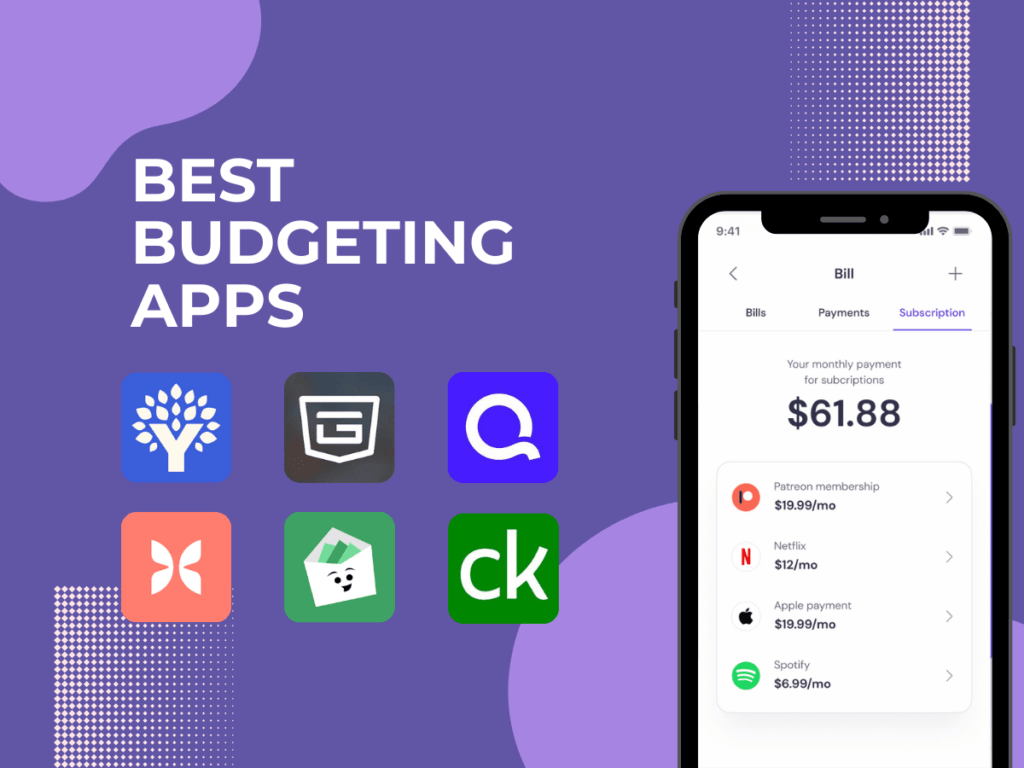Full Review of the Best Budgeting Apps (2024)
-
Written by: Ricardo De Sousa
- Published:

Managing personal finances has never been more crucial than it is today. With 63% of Americans living paycheck to paycheck and nearly half of those earning six-figure salaries, it’s clear that financial strain isn’t just limited to those with lower incomes. On top of that, 77% of Americans are dealing with some form of debt, adding even more pressure. In this environment, a good budgeting app isn’t just a nice-to-have—it’s essential.
Budgeting apps provide the tools you need to track your spending, set financial goals, and break free from living paycheck to paycheck. Studies have shown that people who regularly monitor their expenses and stick to a budget are twice as likely to reach their financial goals. They often save up to 20% more by cutting out unnecessary spending. With real-time insights into your income and expenses, these apps empower you to make smarter decisions, reduce debt, and build a more stable financial future.
In this article, we will explore some of the leading budgeting apps and discuss their strategies, features, and strengths to help you start managing money better.
Different Budgeting Methods
Zero-Based Budgeting Method
The zero-based budgeting method requires you to allocate every dollar of your income to a specific expense, savings, or investment. This ensures that your total income minus your total expenses equals zero. This approach encourages mindful spending and is ideal for those who want detailed expense tracking and accountability.
Envelope System
Originally a cash-only method, the envelope system involves splitting your monthly income into different spending categories, each represented by a physical or digital envelope. Once an envelope is empty, you can’t spend any more in that category until the next month. It’s a simple yet effective way to control spending.
50/30/20 Rule
This method is all about balance. You divide your after-tax income into three categories: 50% for necessities, 30% for wants, and 20% for savings and debt repayment. It requires less detailed tracking but still helps you stay on top of your finances.
Pay Yourself First
This method focuses on prioritizing your savings and investments. Before you start spending on anything else, a portion of your income is automatically set aside for these goals. It’s a great way to ensure that you’re consistently building wealth over time.
Methodology
To determine the top budgeting apps, we assessed them based on the following criteria:
- User Experience & Ease of Use: A budgeting app must be intuitive and easy to navigate to encourage consistent use.
- Features & Integrations: The value of an app depends on what it offers and how well it can connect with your bank and other tools.
- Security: Protecting your financial data is non-negotiable. We looked for strong security features like two-factor authentication (2FA), biometric authentication, and encryption to keep your information safe.
- Pricing: We focused on finding apps that give you the best value. After all, spending money on an app should help you save more money, not work against your financial goals.
Best Budgeting Apps
YNAB (You Need A Budget)
YNAB isn’t just a budgeting app; it’s a complete system designed to help you take charge of your personal finances. It uses the zero-based budgeting method, which means you assign every dollar you earn a specific purpose, whether it’s for bills, savings, or even fun money. This proactive approach keeps your financial goals front and center and helps you avoid overspending.
According to YNAB, new users typically save around $600 in their first two months and more than $6,000 in their first year. The real value of YNAB isn’t just in tracking your expenses; it’s in how it shifts your mindset about money. It’s about learning to prioritize spending and planning ahead, rather than just reacting to what’s in your account.
Ease of Use
While YNAB has a lot going for it, it can be a bit daunting for beginners. The app’s interface is clean and straightforward, making it easy to navigate once you get the hang of things. But YNAB’s unique budgeting system can take some getting used to, especially if you’re new to these principles.
The good news is that YNAB provides plenty of resources to help you get started. Their online workshops, video tutorials, and detailed help guides are incredibly helpful for new users. Once you’ve got the basics down, managing your budget becomes second nature—but be prepared to spend some time learning how it all works.
Key Features
- Goal Tracking: Set and track specific financial goals, such as saving for a vacation or paying off debt.
- Reports: Create detailed reports that break down your spending, income, and net worth over time.
- Bank Syncing: Automatically import transactions from your bank accounts, credit cards, and other financial institutions.
- Create Custom Categories: You can categorize expenses and incomes to fit your financial goals.
- Debt Payoff Planner: A tool to help you prioritize and tackle debt, complete with visual aids to show your progress.
- Mobile App: A full-featured mobile app that lets you manage your budget on the go, so you’re always in control.
- Real-Time Sync: Syncs across multiple devices, so all users in a household have the latest budget updates.
Security
When it comes to handling financial data, YNAB takes security seriously. Here’s how they keep your information safe:
- Data Encryption: All data transmitted between your device and YNAB’s servers is encrypted using bank-grade 256-bit SSL encryption.
- Two-Factor Authentication (2FA): Adds an extra layer of security by requiring a second form of verification besides your password.
- No Data Selling: YNAB has a strict policy against selling user data to third parties.
- Daily Backups: Regular data backups ensure that your financial information is always secure and recoverable.
Pricing
YNAB operates on a subscription model, offering a 34-day free trial so users can explore the app before committing. After the trial, you can choose between two pricing options:
- Monthly Plan: $14.99 per month
- Annual Plan: $99 per year (equivalent to $8.25 per month)
While YNAB is pricier than some other budgeting apps, the annual subscription offers the best value, especially for users dedicated to mastering YNAB’s philosophy.
Who Should Use YNAB?
YNAB is perfect for people who are serious about taking control of their finances and are willing to put in the time and effort to maintain a detailed budget. It’s ideal for those looking to pay off debt, save aggressively, or take a more proactive approach to managing their money.
PocketGuard
PocketGuard is built around a straightforward yet effective budgeting system that shows you how much “pocket money” you have left after accounting for bills, goals, and necessities. With its growing popularity, especially among millennials and Gen Z, PocketGuard’s appeal lies in its ability to give you a clear, real-time snapshot of your finances, making it easier to make informed spending decisions.
Ease of Use
One of the standout features of PocketGuard is its ease of use. The app is designed with a clean, modern interface that’s easy to navigate, regardless of your tech skills. It avoids overwhelming you with too much information and instead guides you through a simple setup process. Linking your bank accounts and customizing your budget categories is a breeze, making it accessible for users at any level.
Key Features
- “In My Pocket” Feature: This feature calculates your disposable income after accounting for bills, goals, and necessities, helping you steer clear of overspending.
- Bill Tracking: PocketGuard keeps tabs on your upcoming bills and due dates, so you never miss a payment.
- Savings Goals: You can set and track savings goals to stay focused on your financial objectives.
- Categorization: The app automatically sorts your expenses into categories, giving you a clear picture of where your money is going.
- Cash Flow Reports: Get detailed reports on your cash flow to spot spending patterns and find areas where you can cut back.
- Bank Account Integration: PocketGuard integrates with your bank accounts to provide real-time updates and ensure accurate budgeting.
Security
PocketGuard implements robust measures to keep your data safe. These include:
- Bank-Level Encryption: PocketGuard uses 256-bit SSL encryption to protect your data during transmission.
- PIN and Biometric Authentication: Adds an extra layer of security by allowing you to set a PIN or use fingerprint or facial recognition to access the app.
- Read-Only Access: PocketGuard connects to your bank accounts in a read-only mode, ensuring that it cannot move or modify funds in any way.
Pricing
PocketGuard offers a free version that comes with basic features, making it a great option for those just starting with budgeting. If you’re looking for more advanced tools, there’s a paid version available at $4.99 per month or $34.99 annually. The paid version unlocks features like customizable categories, cash flow analysis, and unlimited goals. The annual plan offers the best value, especially if you’re ready to commit for a year.
Who Should Use PocketGuard?
PocketGuard is the best budgeting app for college students and young professionals looking for an easy-to-use budgeting app to manage their day-to-day finances. With its intuitive features, real-time bank integration, and affordable pricing—especially the free version—it’s ideal for anyone with simple financial needs who wants to stay on top of their personal finance.
Goodbudget
Goodbudget is a straightforward digital budgeting app that helps users manage their finances through the envelope budgeting method. It’s ideal for individuals and families who want to keep their budgeting process simple without dealing with overly complex features. The app stands out for its simplicity, focusing on the envelope method, which is effective in helping people avoid overspending.
Ease of Use
Goodbudget shines in its user-friendliness. Setting up envelopes, recording transactions, and getting a quick view of your financial health is straightforward. The app’s clean and intuitive design ensures that users can navigate without distractions.
Key Features
- Envelope Budgeting System: Allocate funds into different categories (or envelopes) to keep your spending under control.
- Cross-Platform Syncing: Sync your budget across multiple devices, making it easy to share with family members or partners.
- Transaction History: Keep track of all your expenses and income in one place, with easy categorization for each transaction.
- Reports & Insights: Generate detailed reports to understand your spending patterns and see where your money is going.
- Debt Tracking: Stay on top of your financial goals by tracking and managing your debt repayment.
- Manual Entry of Transactions: For those who prefer not to link their bank accounts, the manual entry option gives you full control over your data.
Although Goodbudget doesn’t integrate directly with banks or financial institutions, its manual entry system suits users who prefer to handle their budgeting without granting app access to their bank accounts.
Security
- Data Encryption: Your data is encrypted to keep it safe from unauthorized access.
- Password Protection: Strong password requirements help secure your account.
- No Bank Integration: Since the app doesn’t link to your bank, your banking information stays private.
- Regular Backups: The app regularly backs up your data, ensuring it’s safe from loss.
Pricing
The pricing options are:
- Free Plan: Includes a limited number of envelopes and basic features.
- Plus Plan: $7 per month or $60 per year, which includes unlimited envelopes, syncing across five devices, and priority support.
The Plus Plan is ideal for users who need more flexibility and advanced budgeting features.
Who Should Use Goodbudget?
Goodbudget is perfect for anyone who wants to manage their finances without linking a bank account to their budgeting app. It’s especially great for beginners or anyone who prefers the envelope budgeting method.
Credit Karma
While Credit Karma is best known for its credit monitoring services, it also offers solid budgeting tools that make managing your finances easier. The app not only gives you real-time updates on your credit score but also provides personalized financial advice. With millions of users, it’s become a popular choice for people who want to keep an eye on their credit score and manage their spending all in one place.
Ease of Use
Credit Karma is designed to be user-friendly. The setup process is simple, and the app includes guided tutorials to help you navigate its features without any hassle.
Key Features
- Credit Score Monitoring: Get real-time updates on your credit score, along with personalized tips on how to improve it.
- Credit Report Access: Access your credit report for free, making it easier to spot any changes or errors.
- Spending Insights: Track and categorize your expenses, helping you see where your money goes and where you can save.
- Debt Management: Receive tailored strategies for managing and paying off debt based on your financial situation.
- Financial Product Recommendations: Discover credit cards, loans, and other financial products that match your credit profile.
- Tax Filing Assistance: Get free tax filing options and personalized advice through integrated tax services.
- Bank Account Integration: Links to your bank accounts for a complete overview of your finances.
Security
Since Credit Karma connects to your bank accounts and handles sensitive financial information, it takes several steps to keep your data secure:
- Encryption: All your data is encrypted, whether it’s being transmitted or stored.
- Multi-Factor Authentication (MFA): Users can enable MFA for an extra layer of security.
- Bank-Level Security: The app uses the same security measures that banks do to protect your information.
- Regular Security Audits: Credit Karma regularly undergoes security audits to meet industry standards.
- Privacy Policy Transparency: The app clearly explains how your data is collected, used, and protected.
Pricing
One of the best things about Credit Karma is that it’s completely free. The app makes money through affiliate partnerships, so you can use all its features at no cost. Thus, making it one of the best free budgeting apps available.
Who Should Use Credit Karma?
Credit Karma is ideal for anyone looking for a one-stop solution for credit monitoring and budgeting. It’s especially useful for those focused on improving their credit scores, with the added benefit of being a free app.
Monarch Money
Monarch Money is a versatile budgeting app that, much like YNAB, uses a zero-based budgeting method. What sets it apart is how it pulls all your financial details together in one place. Whether it’s tracking your spending, savings, and investments, or just getting a clear picture of your financial health, Monarch Money makes it simple.
Ease of Use
The app’s dashboard is clean and intuitive, giving you a snapshot of your finances at a glance. Setting up accounts and budgets is straightforward, and the design ensures that everything you need is easy to find.
Key Features
Monarch Money is packed with features designed to make managing your money smoother and more efficient. Here are some highlights:
- Comprehensive Account Aggregation: Connect all your financial accounts—banks, credit cards, loans, investments—and see your full financial picture in one place.
- Customizable Budgeting: Create budgets that fit your unique needs and goals, complete with custom categories and spending limits.
- Goal Tracking: Whether you’re saving for a vacation or paying off debt, you can set and monitor your financial goals with ease.
- Investment Monitoring: Keep an eye on your investment portfolio, track performance, and stay informed about your financial growth.
- Expense Tracking: The app automatically categorizes your expenses, making it easy to see where your money goes each month.
- Bill Reminders: Get alerts for upcoming bills, so you never miss a payment.
- Collaboration Features: Perfect for couples or families, Monarch Money lets you collaborate on financial planning with shared access to accounts and budgets.
Security
The app employs a variety of security measures, such as:
- 256-bit Encryption: All data transmitted between the app and its servers is encrypted to protect your information.
- Two-Factor Authentication (2FA)
- Read-Only Access: The app can view your transactions and balances but can’t move money, ensuring your accounts are secure.
- Regular Security Audits: Monarch Money regularly conducts audits to spot and fix any potential vulnerabilities.
Pricing
Monarch Money offers several pricing tiers to cater to different user needs:
- Free Plan: Access basic features like account aggregation, expense tracking, and budgeting tools.
- Premium Plan: For $9.99/month or $89.99/year, you unlock advanced features like investment tracking, goal setting, and enhanced customer support.
The Premium Plan offers the best value, especially if you’re serious about getting the most out of the app.
Who Should Use Monarch?
Monarch Money is the best budgeting app for couples thanks to its collaboration features, and for anyone looking for a holistic approach to managing their finances. It’s also a great alternative to YNAB, offering a similar robust feature set at a more affordable price.
Quicken Simplifi
Quicken Simplifi is designed to make budgeting easier by helping you keep track of your cash flow, monitor your expenses, and manage your investments. What sets it apart is how it gives you a clear, real-time snapshot of your financial health, using simple tools that help you stay on top of your financial goals.
Ease of Use
Navigating Simplifi is simple as the name suggests, with a user-friendly design that makes it easy to find and use the features you need. It’s perfect for anyone new to budgeting apps because it doesn’t come with a steep learning curve.
Key Features
- Customizable Spending Plan: You can tailor your budget to fit your spending habits and financial goals, making it truly your own.
- Real-Time Cash Flow Monitoring: With a current view of your income and expenses, you’ll always know where you stand financially.
- Automatic Transaction Categorization: Simplifi saves you time by automatically categorizing your transactions, helping you keep things organized and accurate.
- Investment Tracking: Keep an eye on your investments and how they’re performing, all within the same app.
- Bill Tracking and Alerts: Never miss a payment with reminders that help you stay on top of due dates and avoid late fees.
- Goal Setting: Whether you’re saving for a vacation, a new car, or paying off debt, you can set and track your financial goals.
- Bank Syncing: Simplifi connects with thousands of financial institutions, so your accounts update in real-time for a complete financial picture.
Security
- Bank-Level Encryption: They use the same 256-bit encryption that banks do to keep your data safe.
- Multi-Factor Authentication (MFA)
- Touch ID and Face ID Login: You can quickly and securely log in on your mobile device using your fingerprint or facial recognition.
- Data Anonymization: Your personal information is anonymized to protect your privacy.
- Read-Only Access: Simplifi only reads data from your bank accounts, so it can’t make any changes to them.
Pricing
Quicken Simplifi doesn’t have a free version, but the pricing is pretty straightforward:
- Monthly Plan: $5.99 per month
- Annual Plan: $47.99 per year
The annual plan is the better deal, offering a solid discount compared to paying monthly. Considering the features and security it offers, Simplifi is competitively priced, especially if you’re looking for a simple yet effective budgeting tool.
Who Should Use Simplifi?
Quicken Simplifi is a great fit for anyone looking for an easy-to-use budgeting app that doesn’t skimp on features. It’s especially good for those who want to keep a close eye on their finances without getting overwhelmed. With its bank integration, investment tracking, and goal-setting capabilities, Simplifi makes managing your money easier and more efficient.
Google Sheets/Excel
Although Google Sheets and Microsoft Excel aren’t specifically designed as budgeting apps, they offer an unmatched level of flexibility and customization. This makes them a favorite among those who prefer a hands-on approach to managing their finances. Typically, users rely on templates to manually track their income and expenses.
Ease of Use
How easy it is to use Google Sheets or Excel really depends on how comfortable you are with spreadsheet software. If you’ve got some basic know-how, you’ll probably find navigating these tools pretty straightforward and user-friendly. But for beginners, especially those unfamiliar with formulas and functions, there can be a steep learning curve. Unlike dedicated budgeting apps that guide you through every step, Google Sheets and Excel require you to either build your own templates or import them. Luckily, there are tons of resources, tutorials, and ready-made templates online to help you get started.
Key Features
- Customizable Templates: You can create or download budgeting templates tailored to your specific needs.
- Advanced Formulas: These tools offer powerful formulas and functions that can automate calculations, track spending, and even project future expenses.
- Data Visualization: You can easily create charts and graphs to get a visual sense of your spending habits and overall financial health.
- Cloud Integration (Google Sheets): With Google Sheets, you can collaborate in real-time and access your spreadsheets from any device with an internet connection.
- Add-Ons and Extensions: Both platforms support add-ons that enhance functionality, such as linking to bank accounts or importing financial data.
- Compatibility: Excel files can be easily imported into Google Sheets, and vice versa, giving you flexibility in how you use these tools.
Security
- Google Sheets:
- Data Encryption: All data is encrypted both in transit and at rest.
- Two-Factor Authentication
- Access Control: You can control who has access to your spreadsheets, with options to allow viewing only or full editing permissions.
- Excel:
- Password Protection: You can password-protect individual spreadsheets or entire workbooks.
- Data Encryption: Files can be encrypted to prevent unauthorized access.
- OneDrive Integration: If you use Excel with OneDrive, you get additional security features like ransomware detection and recovery.
Pricing
Google Sheets is completely free to use with a Google account, making it an excellent option if you want a powerful budgeting tool without spending a dime. Excel, on the other hand, is part of the Microsoft Office Suite, which requires a subscription. Microsoft 365 plans start at about $69.99 per year for personal use. While this cost might be a factor, Excel’s added features and integrations could justify the expense if you need more advanced functionality.
For most people, Google Sheets offers the best value for money, especially given its robust capabilities at no cost. But if you’re deeply invested in the Microsoft ecosystem or need those advanced features, Excel is a strong alternative.
Who Should Use Spreadsheets?
Even though they aren’t specifically budgeting apps, Google Sheets and Excel are incredibly customizable, making them perfect for those who enjoy a DIY approach to budgeting. Plus, Google Sheets’ free pricing makes it an appealing option if you’re looking for a cost-free alternative to traditional budgeting apps.
Frequently Asked Questions
Are Budgeting Apps Worth It?
Yes, budgeting apps can be incredibly helpful for managing your money, improving your financial health, and building long-term wealth. They can assist you in paying off debt, organizing your finances, and managing your spending more effectively.
What is the Best Budgeting App for Me?
The best budgeting app for you really depends on your personal needs and preferences. Look for apps that offer a free version or trial period, and consider those with features like investment tracking and customizable budgets.
How Do I Connect My Bank Accounts to a Budgeting App?
Most budgeting apps let you sync your bank accounts, credit cards, and savings accounts for seamless tracking. Look for apps that offer automatic expense tracking and categorization, and always review the app’s privacy policy and terms of service before connecting your accounts.
Related Posts


